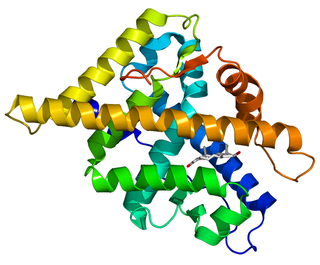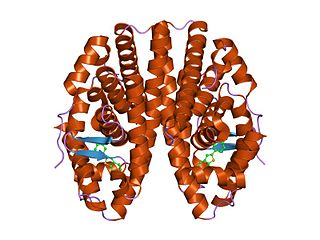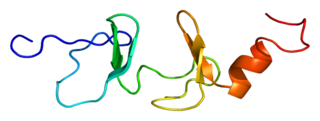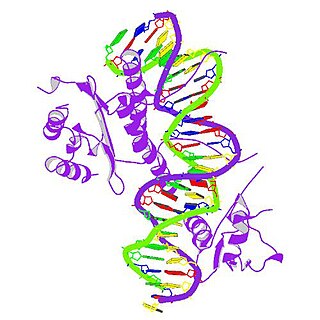E3 ubiquitin-protein ligase RNF14 is an enzyme that in humans is encoded by the RNF14 gene. [5] [6] [7]
E3 ubiquitin-protein ligase RNF14 is an enzyme that in humans is encoded by the RNF14 gene. [5] [6] [7]
The protein encoded by this gene contains a RING zinc finger, a motif known to be involved in protein-protein interactions. This protein interacts with androgen receptor (AR) and may function as a coactivator that induces AR target gene expression in prostate. A dominant negative mutant of this gene has been demonstrated to inhibit the AR-mediated growth of prostate cancer. This protein also interacts with class III ubiquitin-conjugating enzymes (E2s) and may act as a ubiquitin-ligase (E3) in the ubiquitination of certain nuclear proteins. Five alternatively spliced transcript variants encoding two distinct isoforms have been reported. [7] Another function of RNF14 protein relates to its regulation of the inter-relationship between bioenergetic status and inflammation. It influences the expression of mitochondrial and immune-related genes in skeletal muscle including cytokines and interferon regulatory factors. [8]
RNF14 has been shown to interact with the Androgen receptor. [5] [9] [10] [11]

The androgen receptor (AR), also known as NR3C4, is a type of nuclear receptor that is activated by binding any of the androgenic hormones, including testosterone and dihydrotestosterone in the cytoplasm and then translocating into the nucleus. The androgen receptor is most closely related to the progesterone receptor, and progestins in higher dosages can block the androgen receptor.
In molecular biology and genetics, transcription coregulators are proteins that interact with transcription factors to either activate or repress the transcription of specific genes. Transcription coregulators that activate gene transcription are referred to as coactivators while those that repress are known as corepressors. The mechanism of action of transcription coregulators is to modify chromatin structure and thereby make the associated DNA more or less accessible to transcription. In humans several dozen to several hundred coregulators are known, depending on the level of confidence with which the characterisation of a protein as a coregulator can be made. One class of transcription coregulators modifies chromatin structure through covalent modification of histones. A second ATP dependent class modifies the conformation of chromatin.

Ran also known as GTP-binding nuclear protein Ran is a protein that in humans is encoded by the RAN gene. Ran is a small 25 kDa protein that is involved in transport into and out of the cell nucleus during interphase and also involved in mitosis. It is a member of the Ras superfamily.

The nuclear receptor coactivator 2 also known as NCoA-2 is a protein that in humans is encoded by the NCOA2 gene. NCoA-2 is also frequently called glucocorticoid receptor-interacting protein 1 (GRIP1), steroid receptor coactivator-2 (SRC-2), or transcriptional mediators/intermediary factor 2 (TIF2).

The nuclear receptor coactivator 3 also known as NCOA3 is a protein that, in humans, is encoded by the NCOA3 gene. NCOA3 is also frequently called 'amplified in breast 1' (AIB1), steroid receptor coactivator-3 (SRC-3), or thyroid hormone receptor activator molecule 1 (TRAM-1).

Transforming growth factor beta-1-induced transcript 1 protein is a protein that in humans is encoded by the TGFB1I1 gene.

Four and a half LIM domains protein 2 also known as FHL-2 is a protein that in humans is encoded by the FHL2 gene. LIM proteins contain a highly conserved double zinc finger motif called the LIM domain.

Nuclear receptor-interacting protein 1 (NRIP1) also known as receptor-interacting protein 140 (RIP140) is a protein that in humans is encoded by the NRIP1 gene.

Nuclear receptor coactivator 4 is a protein that in humans is encoded by the NCOA4 gene. It plays an important role in ferritinophagy, acting as a cargo receptor, binding to the ferritin heavy chain and latching on to ATG8 on the surface of the autophagosome.

Serum response factor, also known as SRF, is a transcription factor protein.

Testicular receptor 4 also known as NR2C2 is a protein that in humans is encoded by the NR2C2 gene.

E3 SUMO-protein ligase PIAS1 is an enzyme that in humans is encoded by the PIAS1 gene.

E3 SUMO-protein ligase PIAS2 is an enzyme that in humans is encoded by the PIAS2 gene.

Nuclear receptor coactivator 6 is a protein that in humans is encoded by the NCOA6 gene.

E3 ubiquitin-protein ligase UBR5 is an enzyme that in humans is encoded by the UBR5 gene.

Ubiquitin/ISG15-conjugating enzyme E2 L6 is a protein that in humans is encoded by the UBE2L6 gene.

RING finger protein 4 is a protein that in humans is encoded by the RNF4 gene.

E3 ubiquitin-protein ligase NRDP1 is an enzyme that in humans is encoded by the RNF41 gene.

TATA element modulatory factor is a protein that in humans is encoded by the TMF1 gene.

Melanoma-associated antigen 11 is a protein that in humans is encoded by the MAGEA11 gene. It is also involved in the androgen and progesterone receptor signaling pathways.
This article incorporates text from the United States National Library of Medicine, which is in the public domain.